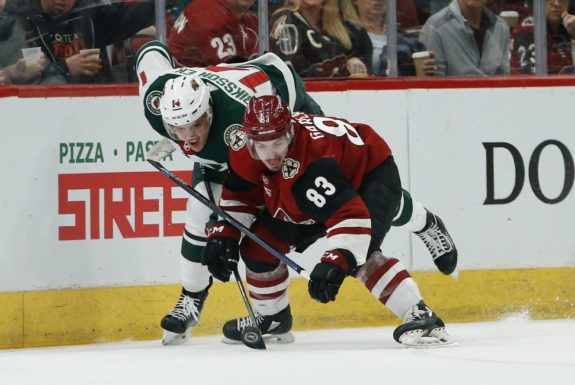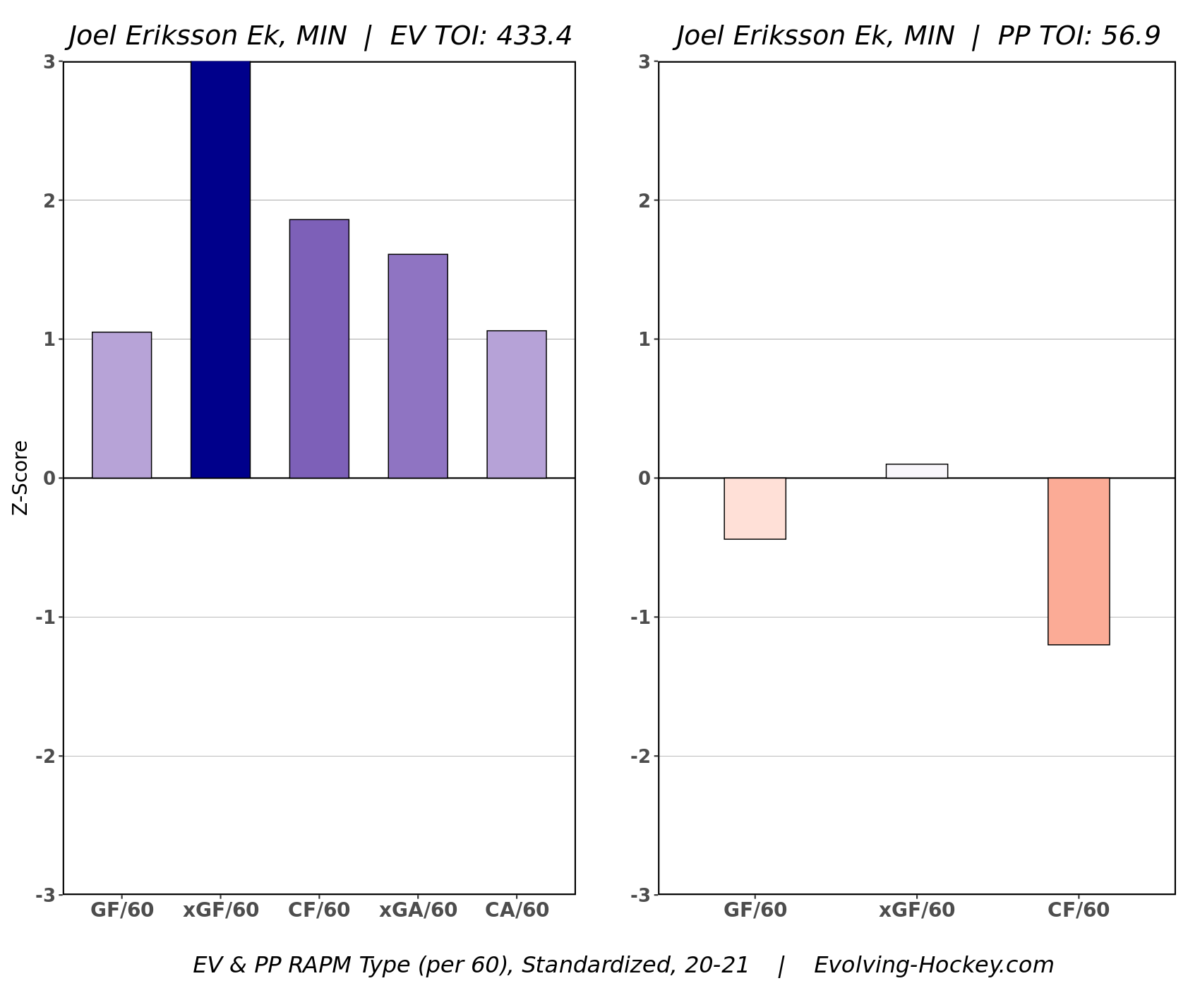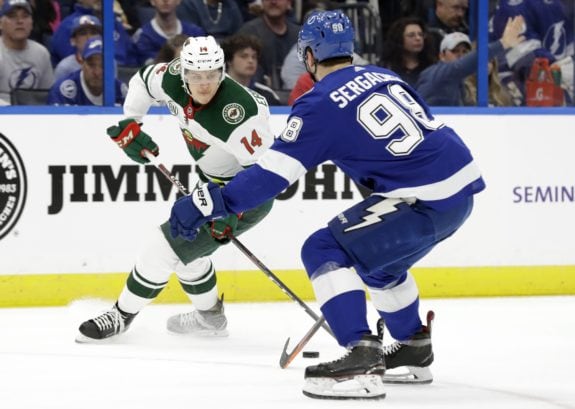The Minnesota Wild are thin down the middle and desperately need a first-line center. This isn’t news, as the Wild have been historically poor at the center position, a problematic area opposing teams have exploited. The issue is that acquiring a top-line center via trade is rare, and the free-agency market this upcoming offseason is bare aside from a couple of options that really don’t move the needle. This leaves the team with a problematic center situation that would be best addressed from within if possible.
But they might just have one in promising youngster Joel Eriksson Ek. The 24-year-old center has most of the tools that are required to be a top-line center that the Wild can depend on at any given time and in any situation. The concern is the fact that the organization has yet to recognize the trajectory of the young center. This further complicates the situation, as the failure to recognize this could lead to poor salary cap and asset management, such as trying to acquire a top-line center via free agency or without identifying one from within.
How it Started
The Wild drafted the Swedish center 20th overall in the first round of the 2015 NHL Entry Draft. His game is similar to former longtime Wild captain Mikko Koivu. While there are certainly evident differences in their game, they both are defensive stalwarts who are effective at defending the league’s best. This leaves the team with a problematic center situation that they should address from within if possible.
Since the draft, it has always come up about how he was the player taken before Brock Boeser, who went to the Vancouver Canucks just three picks later. Boeser has cemented himself as a top-line winger, while Eriksson Ek has been a middle-six, hard-nosed forechecking center. The issue with this is that development is unpredictable, and there shouldn’t be comparisons like these as Eriksson Ek’s two-way dominance is coming to fruition this season.

The Wild knew what they were getting in him, but his development has been a lengthy process, and the results are finally becoming evident in his play. He’s finally performing at a level that was expected of him when they drafted him almost six years ago. The 2015 NHL Entry Draft is paying dividends, as Eriksson Ek, Jordan Greenway, and Kirill Kaprizov were all drafted in that year and are excelling this season.
Two-Way Dominance; Darkhorse for the Selke
Eriksson Ek has elevated his game despite his poor deployment. The Wild have witnessed his breakout this season, and he’s cementing himself as one of the most complete centers in the league. He’s consistently been an elite defensive center, but his offensive game has exploded this season, and it is paying dividends.
The 24-year-old center has 11 goals, 6 assists, and 17 points in 34 games. His 10 goals at 5-on-5 are tied for 10th league-wide, which is pretty impressive for a player in his role. Furthermore, his 7.72 individual expected goals ranks 10th among all forwards league-wide at 5-on-5. He has been one of the biggest factors behind the Wild’s successful start to the season. It will be integral for the team that he is able to sustain this over the entire season.

Eriksson Ek has truly been a dominant two-way force for the Wild this season. He ranks fifth league-wide in RAPM expected goals for per hour, meaning he is generating high-quality scoring chances and shots. If he had finishing ability, he would be an incredibly dangerous player. His high shot share alludes to his strong possession game, which is due to his stylistic approach that helps complement his game.
Not only is Eriksson Ek increasing the Wild’s rate of scoring at a considerable rate, but he is defensively sound and one of the best defensive centers in the league. There is a strong argument that he should be a finalist for the Selke Trophy, a trophy awarded to the best forward in the defensive aspects of the game, which tends to be given to one of the best two-way players.
to provide the perspective of how strong Eriksson Ek has been defensively, he’s allowed 1.89 expected goals against per hour, which is not too far behind Selke frontrunner Aleksander Barkov’s 1.71. Likewise, he has 1.8 defensive goals above replacement — a comprehensive metric that takes all the defensive aspects of the game — according to Evolving-Hockey. He has truly been an effective 200-foot player that has helped the Wild be one of the best 5-on-5 teams in the league. He’s not just dominant defensively at even-strength, but he’s a mainstay on the penalty kill and is a huge reason why the Wild boast one of the best penalty kills in the league.
Poor Deployment
Eriksson Ek is the best center on the team, but Wild head coach Dean Evason has poorly deployed the promising forward this season despite his strong numbers. Either Evason hasn’t recognized the young forward’s potential and strong underlying numbers, or it is his complete stubbornness to change the identity of the lines, or it could be both. While there is no doubt that Evason wants to spread the talent around, one has to wonder if he doesn’t think the young centerman has the potential to be a first-line center. Otherwise, why would you not put your best center on a line with Kaprizov or Fiala this entire season, especially with their lack of center depth?
The Wild’s identity has been to roll four lines they can deploy in any given situation, and as a result, Eriksson Ek is thrown into a third-line forechecking role that hinders his ability to maximize his offensive game because Evason wants to balance the lines.
Eriksson Ek’s 17 points in 34 games — good for his highest pace in points in his career — could be a whole lot higher if Evason gave him an elevated role with the better teammates. It is astonishing that Evason won’t put Eriksson Ek with Kaprizov or put him back on a line with Kevin Fiala over a significant period of games that would display the level of play that he could produce. Kaprizov’s most frequent center is Victor Rask, but he has had time with Nick Bjugstad as well, both of whom are questionable when they have such a dominant two-way presence in Eriksson Ek. Even winger Ryan Hartman has played time with Kaprizov, which is puzzling.

This deployment is hindering Eriksson Ek from maximizing his potential, and it is becoming increasingly problematic. The way Evason has dealt with this complex center situation makes it appear he thinks that the young center is a forechecking third-line defensive center that doesn’t have the talent to be a top-line center. There is no way to justify it as Evason is not playing his best center with one of the best wingers on the team. This “balancing the lines” tactic is not helping the Wild’s complex center situation and is causing bigger problems. This has become an issue at the forefront of the discussions revolving around the struggles the team has had over this last stretch of games that has progressed over the month of March.
The center experiment and balancing the lines has to stop. Play your best center with one of your top wingers.
All of this doesn’t even take into account the top-of-the-lineup that could maximize their potential with a quality center centerman. Kaprizov has ascended to stardom already at the NHL level in the first half of the season, and he did this without an elite center. One has to wonder what his production would look like when he’s not with a center like Rask, who is a fourth-line center on most NHL teams. Likewise, Fiala is on pace for just over 24 goals over an 82-game season, which is respectable, but he has somewhat struggled this season. Eriksson Ek centered a line with Fiala for some of the season, but that didn’t last too long. Evason should, at the very least, put him back on a line with the 24-year-old winger.
Final Thoughts
The fact of the matter is that Eriksson Ek has the potential to be a low-end first-line center for the Wild. He’s molding himself into one of the best two-way centers in the league, and he has displayed his ability to be an offensive contributor this season despite his role.
The question is whether the Wild will recognize his potential to be a top-line center. This will be crucial for them to pick up on because they aren’t deploying him in a situation where he can maximize his potential and display the player he can truly be for the team that has desperately needed help down the middle for years.
(All Data Via Evolving-Hockey, Natural Stat Trick & Hockey-Reference)